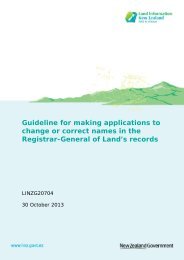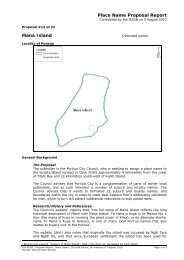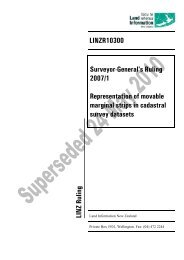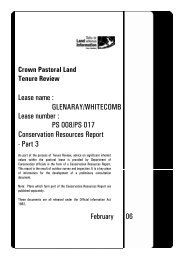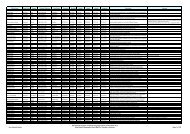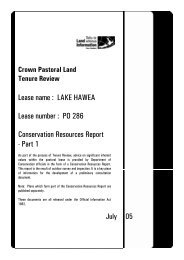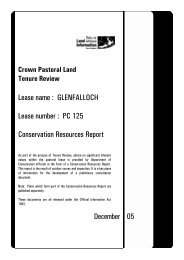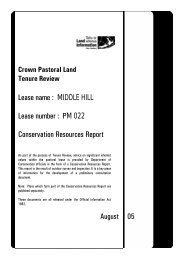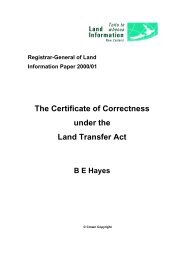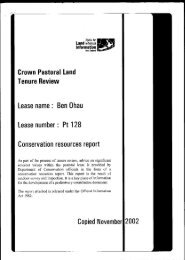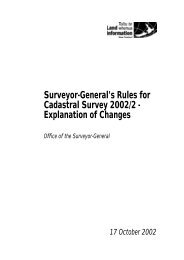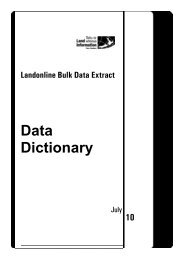Part 1 - Land Information New Zealand
Part 1 - Land Information New Zealand
Part 1 - Land Information New Zealand
Create successful ePaper yourself
Turn your PDF publications into a flip-book with our unique Google optimized e-Paper software.
RELEASED UNDER THE OFFICIAL INFORMATION ACT<br />
2.8 Historic<br />
Background<br />
Previous historic surveys have been undertaken on the PL. Ritchie (1983) undertook survey work<br />
in the late 1970’s along the Kawarau River for the Clutha Valley Development hydro project. Jill<br />
Hamel undertook survey work in 1991 and 1996 for the Protected Natural Area programme with<br />
concise reports on historic features present on the PL. Other sites have been recorded by the Otago<br />
University Expedition in 1976.<br />
There are 20 archaeological sites listed with ArchSite (NZAA) that are located within the bounds<br />
of the PL (Table 6). A further 13 recorded sites are located just outside the PL boundaries.<br />
A previous Conservation Resources Report (DOC 2002) outlines some of the significant historic<br />
resources on the PL. An historic desktop assessment was undertaken June 2011.A further<br />
inspection was undertaken between 19-23 March 2012. The significance of the key historic sites<br />
on the PL is described below.<br />
Pre-contact Maori Sites<br />
There are no recorded Maori sites on the PL although trails were used to access mahika kai<br />
particularly the Cardrona Roaring Meg trail (Waikoroiko). Anderson (1986: cited in Ngai Tahu<br />
2002: 3) described the use of this trail by a Ngati Tama war party under Te Puoho during 1836 -<br />
1837.<br />
The cultural resources report notes the lower reaches of the Low Burn were used by Maori as a<br />
source of fish, eels, and birds and that higher altitude areas yield abundant Taramea (golden<br />
Spaniard) (Ngai Tahu 2002: 2-3). Ritchie (1983: 17) inferred that it is likely Maori used the<br />
Kawarau Gorge as an inland route with small camps sited along the river banks similar to those<br />
recorded along the Cromwell Gorge.<br />
Pastoral Farming<br />
The PL corresponds to two earlier pastoral runs, Queensberry Hill Run 340, straddling the<br />
Roaring Meg, and Mt Pisa Run 245, from Cromwell north to Luggate (Sinclair 2003). The Mt<br />
Pisa run was granted to Herbert Myers ca. 1858 following the break up of Lake Wanaka Station<br />
held by William Thompson and Robert Wilkin. William Thompson and Robert Wilkin took up<br />
the Mt Pisa run in 1859 being the western portion of the Clutha Valley from Wanaka to<br />
the Kawarau (Beattie 1979: 325 cited in Hamel 1990: 2, Parcell 1976: 153 - 4).<br />
The Mt Pisa lease, Run 245, was sold to Russell Howell, Robert Loughnan and Thomas Loughnan<br />
in 1866. The run was managed by Robert Loughnan and a cousin Ignatius Loughnan to be<br />
followed by David Howell. Thomas Somers Cocks, a prominent Canterbury settler, joined the<br />
Russell Howell and Thomas Loughnan partnership in mid - 1868. David Howell took over as<br />
manager of the run in 1885 covering 82,044 acres (George 2011: 8, Parcell 1976: 279).<br />
William Grant Stronach took over management of the Mt Pisa run in 1886 (Pinney 1981: 98).<br />
Stronach was manager until 1896 when he was injured in his coal mine at Cromwell and later<br />
died. Edmund William Parker bought the lease in October 1895 of 148,413 acres and 750 acres<br />
freehold running 42,000 sheep. The run was transferred to Willis Scaife in 1896 (George 2011: 9<br />
- 10).<br />
The Mt Pisa run was sold to Colonel Joseph Cowie Nichols in 1907. Nichols was a Colonel<br />
commanding the Otago Mounted Rifle Brigade. Nichols widow, Helen Nichols, was the last<br />
22



